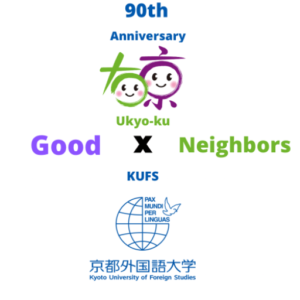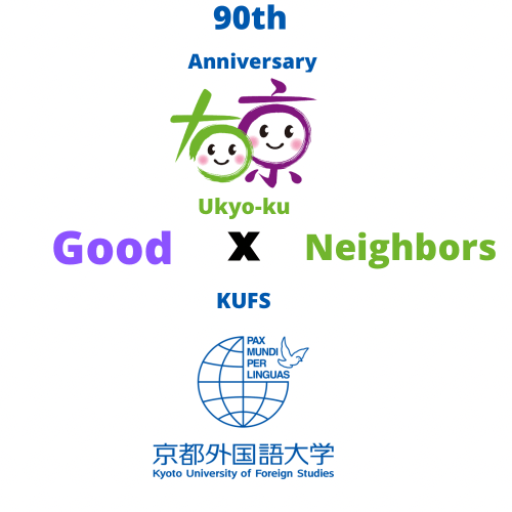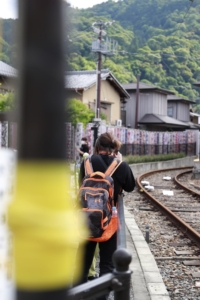The UKYO VOICES Project
About the project
Concept: Good Neighbors
The overall concept of this project was to forge a better understanding between the people of Ukyo-ku and the KUFS community. The key to being good neighbors is to first have good communication. This initiative allowed both sides to engage with each other and share thoughts and ideas for the mutual benefit of all. However, due to the Covid-19 pandemic, and the restrictions that were placed on extra-curricular activities, we had to follow some special precautions with regards to our interactions. This meant spending a good deal of time online rather than in face-to-face meetings, which required our team to be quite creative in preparing for, and conducting, the interviews for the project; in the end, some were in person and some were done on Zoom. Despite these obstacles, all 12 interviews were completed on deadline, several outings were made to gather photographic material, and a great website was created to bring all the pieces together.
The student project team consisted of six pairs of interviewers, who conducted two interviews per pair, two website developers, and two photographers. The students were drawn from three different departments in the university as well as from Kyoto Gaidai Nishi High School and given the opportunity to work with someone that was new and unfamiliar to them. This could have been more than a little challenging, but each of the pairings made a tremendous effort to work through the process together and managed to overcome most hurdles to complete their tasks. The faculty and administration project team of around seven or eight members were positioned to provide logistical support and advice throughout the process, but tried to allow the students as much autonomy as possible in regard to interactions with interviewees and producing the results of their activities. The commitment and professionalism shown by this team surely went a long way to ensuring the success of the whole project. Likewise, without the wonderful level of cooperation shown by the people of Ukyo-Ku, who warmly welcomed our students, and the staff of the Ukyo Ward Office who provided excellent logistical and promotional support, this project would never have been made possible. Their willingness to engage with us at every turn was very much appreciated, and we would like to express our thanks to each and every one of them.
Overall, this was a demanding but rewarding project to be part of, and a fine example of a good, student-centered, community engagement activity, bringing together elements from academia, business, local government and the local community. This kind of initiative will surely become more numerous going forward, and should be seen as an excellent platform for meaningful interaction between people from all walks of life, regardless of age, gender or position. I would like to share here now an outline of the three main parts of the project that make up the website content, as well as the work involved in two key components in the creation of that content.
Living Histories
For the Living Histories part of the project, it was agreed that we should try to interview as broad a generational cross-section of Ukyo-ku residents as possible, from different backgrounds and places of residence, to get a feeling for the way that the ordinary people of the Ward feel, and think, about the place they call home. Once again, the same six pairs of students went out to conduct the interviews and subsequently produced reports on these interactions for placement on the project website:
- Ms. Rio Miura – 1st-year high school student/Baseball player
- Mr. Takatoshi Tsutsui – University student/Community youth police volunteer
- Ms. Shuko Kurokawa – Okami of Sushiyone ryokan
- Ms. Miwa Satake – Marriage counselor
- Mr. Stephen Gill – Haiku expert/Artist/Environmental activist
- Mr. Kunihiro Tokumaru – Director of Frontier Association (NGO)
Ukyo in Action
Ukyo-ku has a wide range of small and medium-sized businesses, as well as several top-level corporations within its borders. In addition, there are a number of NGOs/NPOs and other organizations doing great work in the community and beyond. To report on a broad representation of these institutions, both traditional and modern, interviews were arranged with representatives from one of each of the following:
- Religious institution/Historical site – Ninnaji Temple (World Heritage Site)
- NGO/community-based organization – The Japan Cat Network
- Educational/cultural institution – Minsai Japanese Language School
- Small business – Kameya Hirokiyo (Japanese/Western style confectioners)
- Sports/activity organization or place – Kyoto Hannaryz (Pro-basketball team)
- Agricultural/forestry organization – Sukoyaka Sagano Farm (Urban farming)
Eyes on Ukyo
Each of the two volunteer students for this part of the project focused on taking photographs around Ukyo-ku, taking in as much of everyday life as possible with their camera lenses. Additional photographic material was donated by other students, teachers, and members of the public in order to showcase a truly visual representation of life in the ward. The photos in this section of the website, as well as the images provided for the project’s promotional poster, are intended to be as eye catching as possible, and in many cases, supplement the ideas and themes that come out in the interviews. A genuine collaboration of sight and sound.
Project Website
The two volunteer students in this group worked closely together and were responsible for uploading all relevant project material to the website and updating and adding to the content on a regular basis. They were also responsible for updating and monitoring activity on the SNS platforms employed. In many ways, this might have been the most difficult part of the overall project, as a real need for consistency, accuracy and good time management is required to ensure a quality final product is delivered to the general public. Of course, the development of strong technical skills is a must, and the opportunity to build on these and use them to good effect was at the heart of the successful completion of the project itself.
Bilingual Article Writing
Following the 12 interviews, the students wrote up the interview articles for the website in both Japanese and English. 11 of the 12 articles were written in Japanese first and then translated into English, with one translated from English into Japanese. MiraiTranslator (Mirai Translate, Inc.), a machine translation service (MT), was employed for this, giving the students in this project their first experience of using MT for translation.
One of the outstanding features of MT using AI technology is that it allows for a much higher quality product compared to that when using conventional technology, which is due to its improved translation processing performance. On the other hand, what it produces may contain errors specific to MT, so it is essential to have the translation further examined by a human checker. It is also helpful to learn how to write or alter original documents based on knowledge of the errors or problems that may arise when using MT. Therefore, in this project, before students started on the translation work, they attended a workshop offered by Mirai Translate, Inc., and engaged in activities, that included the necessary procedures of pre-editing and post-editing. In addition, professional translation work almost always involves proofreading by native speakers, so in this project too, native-speaker teachers took on this task before signing off on the completed articles.
[Project partner]
Mirai Translate, Inc. is in full support of this project as a way to promote a better understanding of AI translation among those promising, young individuals who will surely play an important role in our future society.



